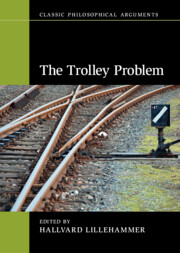Book contents
- The Trolley Problem
- Classic Philosophical Arguments
- The Trolley Problem
- Copyright page
- Contents
- Tables
- Contributors
- Acknowledgments
- Introduction
- 1 Keeping track of your trolleys
- 2 Shunted trolleys and other diversions
- 3 Must we turn the trolley?
- 4 Non-consequentialism in light of the trolley problem
- 5 Non-consequentialist principles under conditions of uncertainty
- 6 The trolley problem and the doing/allowing distinction
- 7 Virtue ethics and the trolley problem
- 8 Trolley dilemmas from the philosopher’s armchair to the psychologist’s lab
- 9 Trolleyology
- 10 Cross-cultural responses to trolley problems and their implications for moral philosophy or
- 11 Ethical accident algorithms for autonomous vehicles and the trolley problem
- 12 A new trolley problem?
- Bibliography
- Index
7 - Virtue ethics and the trolley problem
Published online by Cambridge University Press: 24 February 2023
- The Trolley Problem
- Classic Philosophical Arguments
- The Trolley Problem
- Copyright page
- Contents
- Tables
- Contributors
- Acknowledgments
- Introduction
- 1 Keeping track of your trolleys
- 2 Shunted trolleys and other diversions
- 3 Must we turn the trolley?
- 4 Non-consequentialism in light of the trolley problem
- 5 Non-consequentialist principles under conditions of uncertainty
- 6 The trolley problem and the doing/allowing distinction
- 7 Virtue ethics and the trolley problem
- 8 Trolley dilemmas from the philosopher’s armchair to the psychologist’s lab
- 9 Trolleyology
- 10 Cross-cultural responses to trolley problems and their implications for moral philosophy or
- 11 Ethical accident algorithms for autonomous vehicles and the trolley problem
- 12 A new trolley problem?
- Bibliography
- Index
Summary
Since the publication of Judith Thomson’s 1976 paper, solving the Trolley Problem has been a favorite preoccupation of utilitarians and deontologists. Why is it permissible to divert a runaway trolley, thereby killing one person to save five others, but impermissible to push a big man onto a track to save five others.To date, virtue ethicists have not shown any interest in the debate.An obvious reason for this lack of interest is that virtue ethicists reject the very idea that there are universal moral rules and principles, according to which actions can be evaluated as permissible or impermissible. It is possible to frame the Trolley Problem in terms of what a virtuous person would and wouldn’t do, but then a further problem emerges, namely, that trolley experiments are not good tests of character. They rule out many of the ways that virtuous people can distinguish themselves from the non-virtuous.I discuss some of these problems in the first part of the chapter. In the second part, and with a few reservations and qualifications in mind, I argue that a virtue ethicist can support our commonsense intuitions in two central cases – Bystander and Footbridge – while also offering a response to Thomson’s Loop challenge.
- Type
- Chapter
- Information
- The Trolley Problem , pp. 116 - 133Publisher: Cambridge University PressPrint publication year: 2023



